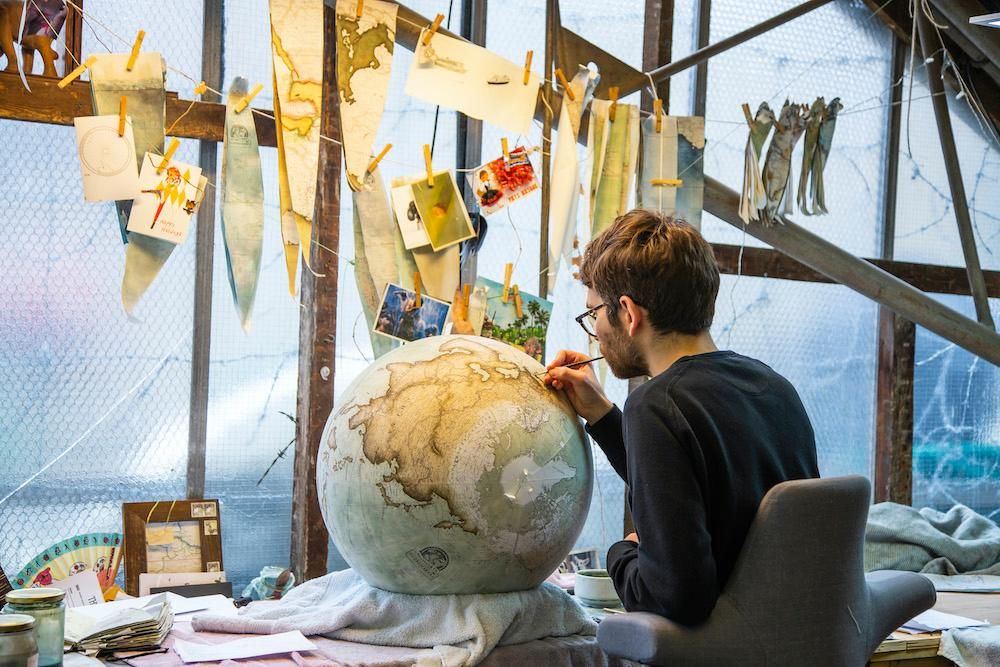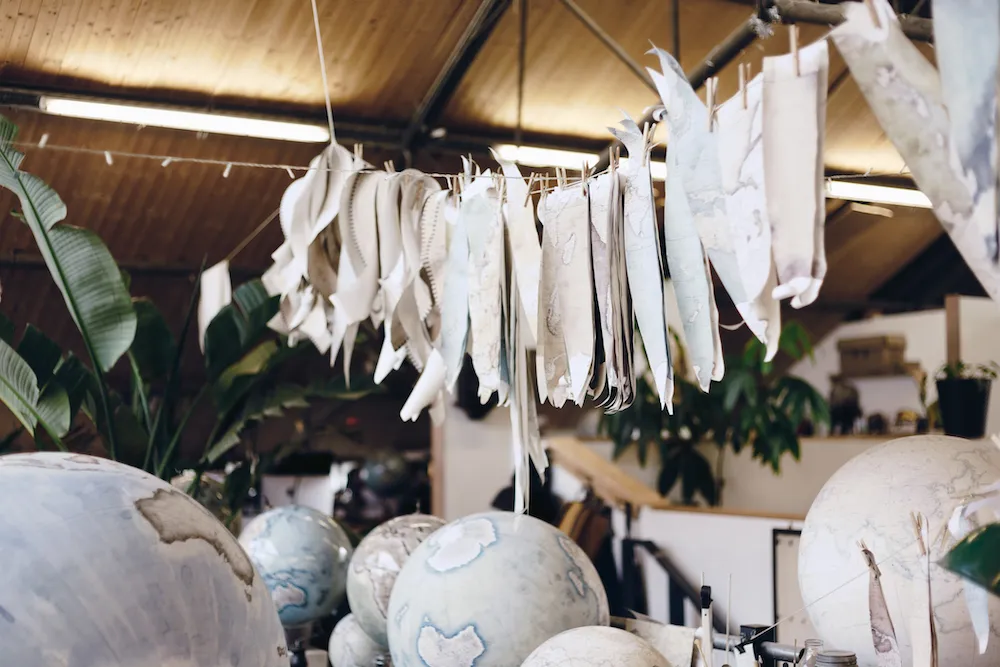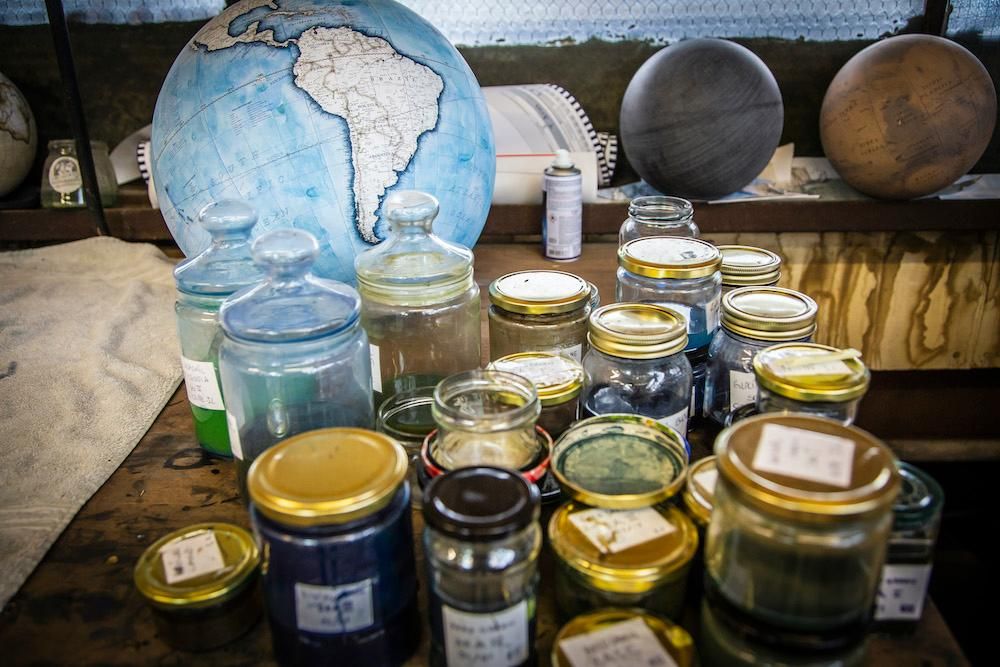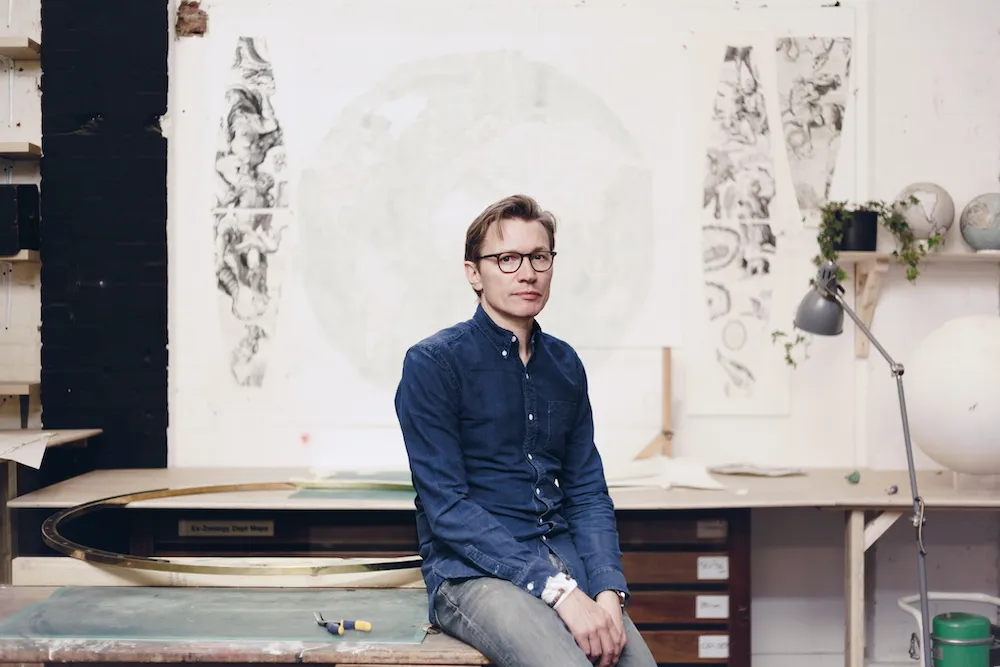Take a Peek Into One of the Last Studios Still Making Globes by Hand
Spinning a globe is one way to ‘travel’ the world during the pandemic
/https://tf-cmsv2-smithsonianmag-media.s3.amazonaws.com/filer/17/e7/17e7257c-3624-4092-821c-d8398f1ba11e/19_img_9128_bellerby_globemakers_photo_by_paul_marc_mitchell.jpg)
Tucked away inside a nondescript building located along a back alley in North London, a team of craftspeople was busily at work putting the finishing touches on a custom, handcrafted globe. With the clock ticking, the artisans at Bellerby & Co., a globemaking studio, only had a few days left before the final piece—a globe measuring more than four feet in diameter—was shipped to a customer awaiting its arrival in Italy. From start to finish, it took artisans almost a year to complete the project, a length of time that might seem excessive in today’s instantaneous world. However, considering that Bellerby & Co. is one of the only remaining ateliers that still makes globes by hand using a meticulous step-by-step process that hasn’t deviated much over the centuries, the end result is worth the wait.
The reason it takes so long for a globe to be made is because nearly every step is done by hand. Peter Bellerby, the company’s founder, says it took him upwards of two years before getting his footing as a globemaker, and he’s still learning something new every day.
“It’s really about learning motor skills,” Bellerby says.

Before founding the company in 2008, Bellerby worked as a property developer, with a brief stint as a violin maker. The thought of becoming a globemaker never crossed his mind until his father said he wanted a globe for his 80th birthday. Not pleased with what was available on the market, he decided to try his hand at making a globe himself. He figured it would take him about three or four months to complete, with enough time to spare to make one for himself. He didn't realize how truly difficult the art of globemaking really is.
Some of the first globes were made by the Greeks, who were the first to create spherical celestial adaptations of the planet. It wouldn't be until the 1490s that geographer Martin Behaim produced the first terrestrial globe. Known as the Erdapfel or "earth apple," it unfortunately is riddled with errors, including a botched depiction of the African coast, but nonetheless, it remains the oldest surviving globe of its kind in history, and is part of the collection at the German National Museum in Nuremberg.
Over the years, globemaking has evolved, but many of the same steps of the process remain in place. In this video from the 1950s, artisans can be seen glueing sheets of newsprint onto a wood sphere before covering it in nine separate coats of plaster until perfectly smooth. The map is then cut and applied by hand. Globemakers today follow similar steps, but in a much more streamlined fashion that relies on computer-created geography, and hardier materials, such as the resin molds that Bellerby employs. Bellerby & Co. bills itself as "one of the last remaining traditional globemakers [in the world.]"
One of the challenges Bellerby faced during his first project was ensuring that the cast of the globe was actually round. He found several manufacturers willing to make him a form, but none were a perfect sphere and they were often riddled with plateaus, something that would make the next step in the process even more challenging (more on that in a second). Not satisfied, Bellerby eventually partnered with a Formula 1 fabricator to make molds of various sizes, from an 8-inch mini desk globe to the massive 4-footer like the one commissioned by the Italian client. Bellerby started out by using plaster of paris in the molds (a material used historically in globemaking, but thanks to technological advancements, is less commonly used today), but through much trial and error he now favors resin and composite, which are more likely to stand the test of time.
“They can hold up for centuries,” he says. “I want to make globes that can be passed down from one generation to the next. [At Bellerby & Co.] we over-engineer every aspect of the process so that the final result is absolutely bulletproof.”

Perhaps the biggest challenge that Bellerby faced was figuring out how to place a rectangular map onto a circular form. Luckily, many centuries ago (during the 15th century to be exact, right around the time when explorer Christopher Columbus set foot in the New World), and through trial and error, globemakers found the solution: slicing a map into triangular shapes called “gores.” This step would allow for easier placement of the map onto the sphere. Although that step may sound simple enough, it’s probably the most challenging skill that globemakers have to master during their apprenticeship to become a full-fledged globemaker.
“The gores take a long time for people to perfect,” Bellerby says. “When you’re doing this, you’re moistening the paper and then stretching it over a sphere. You have to make sure the paper doesn’t rip. It’s one of the most nonintuitive things to begin with. You really have to understand how to move your hands much slower and be very gentle. When you’re picking up the paper [especially in the case of the larger globes], it can rip under its own weight. You would think it’s a very easy thing to do, but it’s one thing to put paper on a sphere and another to make sure that all of the pieces line up correctly.”
Bellerby's studio employs more than 20 craftspeople, from cartographers who design the gored maps (during a commission, clients have the opportunity to customize their globe, highlighting points of interest like their hometown or routes of past travels) to artists who paint on the details once the spheres have been gored, dipping into a wide spectrum of paint and ink pots to help bring each globe to life. With a steady hand, artists highlight each continent by shading in borders, coastlines and other geographic details, ensuring that each brushstroke is perfectly executed while also giving each globe a handcrafted touch. Bellerby estimates that about six people will have touched each globe before it’s ready to be shipped to a client.

This bespoke quality is what caught the eye of Emily Freidenrich, an art historian and author who profiled Bellerby & Co. in her 2019 book Almost Lost Arts: Traditional Crafts and the Artisans Keeping Them Alive.
“I felt like his story and the beauty of globemaking really embody the idea of lost arts,” Freidenrich says. “He’s largely self-taught, and his dedication to getting every step of the process right is fascinating to me. The team he's built is very passionate and dedicated to this work. Globemaking isn't something that you fall into; he looks for people who are interested in the process and are willing to invest the time and energy into doing good work. He's assembled a very harmonious atelier of globemakers.”

That attention to detail has also helped globemaking stay relevant, especially in modern times when most people turn to Google Maps or some other form of GPS for geographical information. However, as many people who have canceled their travel plans due to the Covid-19 pandemic have come to learn, spinning a globe is one way to explore the world without leaving home. In fact, Bellerby saw a roughly 15 percent uptick in globe orders compared with previous years, with the lead time for a finished piece now nearing about a year out. On average, the studio produces about 750 globes each year, with rates starting at about £1,300 ($1,800) for a mini desk globe to £44,500 ($89,000) for the largest model.
“A globe is the ultimate visualization of where we live in the solar system,” Bellerby says. “You have the ability to interact with the globe in a way you can’t [by looking at a computer screen]. Using something like Google Maps to get from point A to point B is really efficient—you don’t drift on Google, you function. On a globe, you can picture your home and visualize where you’re going. Globes constantly remind us how miniscule we are, and how wonderful the world is.”